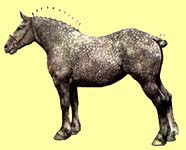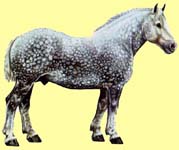|
|
The Percheron |
|
|
The Percheron |
 The Percheron originated in the region of Le Perche in France, and is probably descended from an ancient indigenous breed, which is further said to descend from Equus caballas sequanus. The Le Perche region of France is a land of rich pastures which borders the valley of the river Huisne in Normandy. During the development of the Percheron, it has benefited from the infusion of Oriental blood. This is clearly shown in the velvety coat and by the elegant head. The first of such infusions may have been made in the 8th Century, with horses captured from the Saracens after their defeat at Poitiers. The second is likely to have occurred in the Middle Ages when Comte de Perche imported stallions on his return from the Crusades and expeditions into Spanish territory. A certain proportion of
Spanish blood also exists in the Percheron, deriving from stallions imported from Castille by the Comte de Rotrou.
The Percheron originated in the region of Le Perche in France, and is probably descended from an ancient indigenous breed, which is further said to descend from Equus caballas sequanus. The Le Perche region of France is a land of rich pastures which borders the valley of the river Huisne in Normandy. During the development of the Percheron, it has benefited from the infusion of Oriental blood. This is clearly shown in the velvety coat and by the elegant head. The first of such infusions may have been made in the 8th Century, with horses captured from the Saracens after their defeat at Poitiers. The second is likely to have occurred in the Middle Ages when Comte de Perche imported stallions on his return from the Crusades and expeditions into Spanish territory. A certain proportion of
Spanish blood also exists in the Percheron, deriving from stallions imported from Castille by the Comte de Rotrou.
The small Percheron is known as the Percheron Postier, and is now virtually extinct. The larger version has survived the recent revolutions in transport and agriculture. This larger Percheron has been used in the past for drawing omnibuses in towns and cities and for farm work. The Stud Book dates back to 1883, and since 1996, this Stud Book also includes a series of local breed which derive from the Percheron. These Local breeds are:
The Percheron Society of America has existed since 1978, and maintains its own Stud Book. Introduced into Great Britain from France during World War I, the Percheron had actually been imported from the United States at the end of the 19th Century, proving to be particularly suited to pulling the London omnibus. The British Stud Book has been strictly maintained since 1919. Presently the Percheron is distributed in France, Great Britain, the United States, South America, South Africa, Australia and Japan.
The Percheron has an aptitude for farm and draft work and a very quiet and docile, but energetic temperament. Known for their particularly friendly disposition, the Percheron is strong with good endurance. this handsome, clean-legged and free-moving heavy horse is one of the most elegant of the heavy draft horse breeds. Together with the Boulonnais, which is another elegant heavy horse, it owes a lot to the Oriental influence. It is said to be "an Arabian influenced by climate and the agricultural work for which is has been used for centuries." This statement, made by a 19th Century authority, reflects the strength of the eastern influence even though the authority may have had an excess of enthusiasm for the breed.
This heavy draft is among the oldest breeds of draft horses in France, primarily of North-European stock. A distinct Arabian influence can be found in the head, neck and feet. These traits probably date to when the Numidian riders passed through Gaul while enroute to Britannia, during Roman times. Also, the Arab horses which were captured in the battle at Tours and Poitiers (in AD 732) would have influenced the Percheron. The place of capture of these Barbs or Arabs was not too far from the Le Perche region, making them available to the French breeders. There was certainly an influence of eastern blood, which was introduced after the first Crusade in 1096-1099, and by 1760, the Le Pin stud had made available Arabian sires to the Percheron breeders. Arabian outcrosses which dominated the most influential Percheron lines, were represented by Godolphin and Gallipoly. The most famous of Percheron stallions, Jean le Blanc, was foaled in 1830, and he was sired by Gallipoly.
The Percheron has been used extensively over its long history as a War Horse, coach horse, farm horse and heavy artillery horse, and it has also been used under saddle. While the invention of gunpowder reduced the need for War Horse mounts, the heavier types of horses turned to moving equipment and cannons. The light-colored Percheron variety became favored for stagecoaches as a road system developed in Europe. Perhaps this was due to the greater visibility of pale horses at night. Railways brought an end to stage coaches, but heavy teams remained for some time. The local "bus service" was provided by Percherons in Paris and other European cities.
In 1665, Percherons were among the first of the heavy breeds to arrive in North America when Louis XIV sent 2 stallions and a number of mares to Canada. It wasn't until about 200 years later, that Americans started importing Percherons. As happened with Belgians, American breeders shied away from the subtly toned colors. They favored using blacks instead, and also preferred the larger size. As a result, French breeders began cross breeding their Percherons with the Black Nivernais and other local black breeds. This lucrative trade nearly ruined the Percheron breed in the eyes of the French. The trend was later reversed as the boss hustlers of large circus companies found the advantage of using the dappled grey horses. During World War I, thousands of American Percherons served on the battlefields in Europe and of the 500,000 British horse casualties, a large percentage were either Percherons or of the Percheron-type.
 The grey Percherons were hard to beat for diligence, stamina and general health. They were also easier to train, and to match for parades. Even though grey horses change color throughout their lives, the consistent irregularity of a dappled horse is easier to match than those more uniformly colored. The latter may have additional white markings on the head and feet, which would also be matched. Also some horses tend to fade in color seasonally and with age. This fading is less noticeable in greys. Still, after discovering all the benefits of greys, there is a certain preference for the black variety among American breeders.
The grey Percherons were hard to beat for diligence, stamina and general health. They were also easier to train, and to match for parades. Even though grey horses change color throughout their lives, the consistent irregularity of a dappled horse is easier to match than those more uniformly colored. The latter may have additional white markings on the head and feet, which would also be matched. Also some horses tend to fade in color seasonally and with age. This fading is less noticeable in greys. Still, after discovering all the benefits of greys, there is a certain preference for the black variety among American breeders.
Percherons have found their way into big teams on farms. There it would not be unusual to find a hitch of 30 or more horses. Its friendly and docile temperament makes this breed an ideal choice for team work. While it is unheard of with most other breeds, it is not unusual to see a stallion and a mare working side by side together. These special horses are not just found on farms, in circus companies, or with trucking companies and breweries of Europe and the New World. They are also popular in Japan for one-horse, sulky races. Today's Percheron is immensely powerful and it is hardy and versatile. This heavy horse has a stylish and distinctive, long free and low action. Easily adapted to different climatic conditions, the Percheron has been exported to the Americas, Canada, Australia, South Africa, Japan and even to the Falkland Islands, where it has been crossed with the local Criollo stock. With an unofficial pulling record of 3,410 pounds, the Percheron is exceptionally biddable and he will do any sort of work.
Percherons usually have grey coats, which are typically dappled, though black and roan do occur more rarely. They are typically born black, but only a few remain dark. Most lighten to a dappled grey when mature, which is the one feature most recognizable. Some will even turn completely white. This is the horse of the traditional dappled rocking horse - a very good indicator as to the breed's widespread appeal. The French breed society will even accept the occasional bay, chestnut and roan.
Today there are two varieties within the breed. The small variety stands 14.3 to 16.1 hands at the withers, and weighs 1,320 to 1,760 pounds. The large variety has a height of 16.1 to 17.3 hands and weighs 1,760 to 2,200 pounds. The Percheron, Dr Le Gear, was the world's biggest horse, standing at 21 hands high and weighing 27 cwt. (hundred-weight, or 3,024 pounds). It has a fine, handsome head, which is quite long but harmonious despite its strong jaws, and relatively small proportion to its body. The profile is straight, with a broad, square forehead. The ears are well-proportioned, and large expressive eyes are prominent and alert. It has a flat nose with wide, open "flared" nostrils. It has a short, broad and muscular neck that is slightly arched, and has a fairly thick and full mane, and good general conformation.
Its withers are moderately prominent and its back is sometimes slightly hollow. It has full and rounded loins, and also a wide and rounded croup, which is sometimes double muscled. It has a broad and muscular chest, a wide and deep girth, a rounded abdomen, and its sloped shoulder is nicely rounded and muscular. It is noted for the excellence of the powerful hindquarters, which are sloped and usually long for the breed. Usually put up in a kind of "Polo bang" when in harness, the Percheron has a full tail. The limbs are strong and muscular, with good, hard joints. It has short and robust legs with broad joints, and its pasterns are short and lightly feathered, or there is no feather at all at the heels. The thighs are long and muscular. The large hoof is of dark (blue), tough horn. There is more refinement in the feet than in those of other heavy breeds, and they are a notable feature of this exceptionally popular heavy breed.
For more information on Percheron draft horses visit:

|
© 1997-2007
NW Breyer Horse Club & Refiner of Gold Creations Equinealities in place since 1997, Section in place 2001, Updated 3/13/2007 |



|
| ||

|
|||||